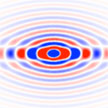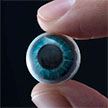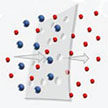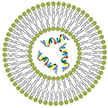Showing Spotlights 401 - 408 of 2881 in category All (newest first):
 Polaritons in biaxial crystals offer a promising route to manipulate nanoscale light-matter interactions. The dynamic modulation of their dispersion is of great significance for future integrated nano-optics but remains challenging. Researchers theoretically demonstrate and experimentally verify such tailored polaritons at the interface of heterostructures. The interface engineering may shed new light on programmable polaritonics, energy transfer, and neuromorphic photonics
Polaritons in biaxial crystals offer a promising route to manipulate nanoscale light-matter interactions. The dynamic modulation of their dispersion is of great significance for future integrated nano-optics but remains challenging. Researchers theoretically demonstrate and experimentally verify such tailored polaritons at the interface of heterostructures. The interface engineering may shed new light on programmable polaritonics, energy transfer, and neuromorphic photonics
Apr 22nd, 2022
 Ongoing smart contact lens research ranges from biosignal detection (intraocular pressure, glucose, cortisol) to therapeutic tools (aniridia, chronic ocular inflammation) and advanced features such as aumented reality displays and personalized designs using 3D-printing technology. Some of these technologies are already finding their way from the lab into commercial applications. The development of next-generation, smart contact lens technology is not just simply one field of bioelectronics but rather a complex, interdisciplinary effort that includes development of biocompatible materials; development of intuitive interfaces; and development of integration technologies capable of smart contact lens research.
Ongoing smart contact lens research ranges from biosignal detection (intraocular pressure, glucose, cortisol) to therapeutic tools (aniridia, chronic ocular inflammation) and advanced features such as aumented reality displays and personalized designs using 3D-printing technology. Some of these technologies are already finding their way from the lab into commercial applications. The development of next-generation, smart contact lens technology is not just simply one field of bioelectronics but rather a complex, interdisciplinary effort that includes development of biocompatible materials; development of intuitive interfaces; and development of integration technologies capable of smart contact lens research.
Apr 18th, 2022
 Driven by advanced nanomaterials and nanofabrication technologies, tremendous progress has been made over the last 15 years in making ultrathin membranes based on a variety of advanced nanomaterials and nanotechnologies. Further pushing membrane thickness to sub-50 nm or even atomic level is appealing to researchers, with the ultrafast permeance that may be enabled and ultimate understanding of formation and transport at the extremely low thickness that can be significantly different from their thicker counterparts.
Driven by advanced nanomaterials and nanofabrication technologies, tremendous progress has been made over the last 15 years in making ultrathin membranes based on a variety of advanced nanomaterials and nanotechnologies. Further pushing membrane thickness to sub-50 nm or even atomic level is appealing to researchers, with the ultrafast permeance that may be enabled and ultimate understanding of formation and transport at the extremely low thickness that can be significantly different from their thicker counterparts.
Apr 12th, 2022
 We have created two inaugural Nanowerk non-fungible token (NFT) collections in a series we are calling Giants of Nanotech in order to honor the great minds of science in this field. The digital artwork has been created using the artificial intelligence (AI) image creation algorithm Neural Style Transfer. The NFTs are tokenized on the Polygon Blockchain as a collectible on the OpenSea marketplace. Have fun with our NFTs and please remember, your purchase helps fund Nanowerk and we are very grateful to you!
We have created two inaugural Nanowerk non-fungible token (NFT) collections in a series we are calling Giants of Nanotech in order to honor the great minds of science in this field. The digital artwork has been created using the artificial intelligence (AI) image creation algorithm Neural Style Transfer. The NFTs are tokenized on the Polygon Blockchain as a collectible on the OpenSea marketplace. Have fun with our NFTs and please remember, your purchase helps fund Nanowerk and we are very grateful to you!
Apr 10th, 2022
 Resonance-based sensors can be used as an advanced tool for gas sensing as they show several advantages as compared to conventional gas sensors like metal-oxide semiconductor and electro-chemical gas sensors. With the introduction of an additional metamaterial layer over the sensor, the selectivity of these sensors can be improved. These article focuses mainly on metamaterial-based split ring resonators (SRR) and complementary SRRs (CSRRs) structures used in several sensing applications.
Resonance-based sensors can be used as an advanced tool for gas sensing as they show several advantages as compared to conventional gas sensors like metal-oxide semiconductor and electro-chemical gas sensors. With the introduction of an additional metamaterial layer over the sensor, the selectivity of these sensors can be improved. These article focuses mainly on metamaterial-based split ring resonators (SRR) and complementary SRRs (CSRRs) structures used in several sensing applications.
Apr 7th, 2022
 A recent review article highlights how nanoscience and nanotechnology can solve three acute problems in the treatment, prevention, and diagnosis of viruses like SARS-CoV-2: 1) synthesis of novel drugs and vaccines based on nanocarriers with enhanced efficiency and reduced side-effects for the treatment of the current pandemic and the prevention of future virus attacks; 2) design of protective equipment based on nanoparticles, such as medical face masks and outfits and 3) development of nanobiosensors for early detection of infections in a maximally efficient way.
A recent review article highlights how nanoscience and nanotechnology can solve three acute problems in the treatment, prevention, and diagnosis of viruses like SARS-CoV-2: 1) synthesis of novel drugs and vaccines based on nanocarriers with enhanced efficiency and reduced side-effects for the treatment of the current pandemic and the prevention of future virus attacks; 2) design of protective equipment based on nanoparticles, such as medical face masks and outfits and 3) development of nanobiosensors for early detection of infections in a maximally efficient way.
Apr 6th, 2022
 Combining the benefits of both fluid and solids, researchers have demonstrated various functions for their slimebots, including navigation in narrow channels much smaller than their size; object capture operations via the curl or endocytosis modes; and circuit repair and controlled switching using their own conductive properties that can even be reconfigured as self-healing strain sensors for monitoring human motion. The widely applicable working environment of these novel magnetic slime robots make them promising for future applications in biomedical and wearable devices.
Combining the benefits of both fluid and solids, researchers have demonstrated various functions for their slimebots, including navigation in narrow channels much smaller than their size; object capture operations via the curl or endocytosis modes; and circuit repair and controlled switching using their own conductive properties that can even be reconfigured as self-healing strain sensors for monitoring human motion. The widely applicable working environment of these novel magnetic slime robots make them promising for future applications in biomedical and wearable devices.
Apr 4th, 2022
 A lithography-free method for printing optical metasurfaces with resonant laser printing can achieve metasurfaces for structural colors, optical holograms, and diffractive optical elements, with an energy consumption of less than 1 nanojoule and a print time down to 1 nanosecond per dot. The performance of this ink-free laser color printing with a resolution of more than 100 000 dpi by far exceeds the output of conventional laser printers. The nanoscale structures made on a multi-layer film are robust and typically could last longer than most inks or pigments.
A lithography-free method for printing optical metasurfaces with resonant laser printing can achieve metasurfaces for structural colors, optical holograms, and diffractive optical elements, with an energy consumption of less than 1 nanojoule and a print time down to 1 nanosecond per dot. The performance of this ink-free laser color printing with a resolution of more than 100 000 dpi by far exceeds the output of conventional laser printers. The nanoscale structures made on a multi-layer film are robust and typically could last longer than most inks or pigments.
Mar 24th, 2022
 Polaritons in biaxial crystals offer a promising route to manipulate nanoscale light-matter interactions. The dynamic modulation of their dispersion is of great significance for future integrated nano-optics but remains challenging. Researchers theoretically demonstrate and experimentally verify such tailored polaritons at the interface of heterostructures. The interface engineering may shed new light on programmable polaritonics, energy transfer, and neuromorphic photonics
Polaritons in biaxial crystals offer a promising route to manipulate nanoscale light-matter interactions. The dynamic modulation of their dispersion is of great significance for future integrated nano-optics but remains challenging. Researchers theoretically demonstrate and experimentally verify such tailored polaritons at the interface of heterostructures. The interface engineering may shed new light on programmable polaritonics, energy transfer, and neuromorphic photonics
 Subscribe to our Nanotechnology Spotlight feed
Subscribe to our Nanotechnology Spotlight feed





